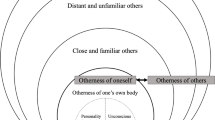Abstract
In the construal of self and others, highly diverse, idiosyncratic, and evocative adjectival terms were manifested as contrasting, opposite terms for a set of supplied constructs rather than conventional antonyms. These “personal contrasts” are seen as a neglected companion to George Kelly’s (The Psychology of Personal Constructs, 1955) conception of “personal constructs”. These construct/contrast pairings are seen as representing connected, complementary aspects of an essential unity such that each side of a pair informs the meaning of the other. This complementarity, long recognized in an extensive literature on polar, dichotomous, and binary pairs in the physical and social worlds, is seen as having applicability to many descriptive adjectives. It is suggested that adjectival complementary pairings often involve unique associative linkages, the tracing of which could prove fruitful for understanding the construal of self and others.
Similar content being viewed by others
References
American Psychiatric Assn. (1994). Diagnostic and Statistical Manual of Mental Disorders, Fourth Edition. (DSM-IV). Washington, DC: American Psychiatric Association.
Ashton M.C., Goldberg L.R. and Lee K. (2004). A hierarchical analysis of 1,710 English personality-descriptive adjectives. Journal of Personality and Social Psychology 87: 707–721
Bannister D. (Eds.) (1977). New perspectives in personal construct theory. Academic Press, London
Bannister D. and McNair J.M.M. (1968). The evaluation of personal constructs. Academic Press, London
Bohr N. (1958). Atomic physics and human knowledge. Wiley, New York
Chetwynd J. (1977). The psychological meaning of structural measures derived from grids. In: Slater, P. (eds) The measurement of intrapersonal space by grid technique, Dimensions of intrapersonal space (Vol 2), pp 175–194. Wiley, London
Fransella F. and Bannister D. (1977). A manual for repertory grid technique. Academic Press, London
Hallpike C.R. (1979). The foundations of primitive thought. Clarendon Press, Oxford
Hoeksema, J., Rullman, H. Sanchez-Valencia, V., & van der Wouden, T. (Eds.). (2001). Perspectives on negation and polarity items. Philadelphia, PA: Benjamin Publishing Co.
Kelly G.A. (1955). The psychology of personal constructs. (Vols. I & II). Norton, New York
Kelso J.A.S. and Engstrom D.A. (2006). The complementary nature. MIT Press, Cambridge, MA
Koch E. (2006). Personal constructs and psychodynamic psychotherapy: A case study. Psychoanalytic Psychology 23: 554–578
LandfieldA.W. Epting F.A. (1987). Personal construct psychology: Clinical and personality assessment. Human Sciences Press, New York
Needham R. (1973). Right & Left: Essays on dual symbolic classification. University of Chicago Press, Chicago
Needham R. (1987). Counterpoints. University of California Press, Berkeley, CA
Neimeyer R.A. and Neimeyer G.J. (2002). Advances in personal construct psychology: New directions and perspectives. Praeger, Westport, CT
Ogden, C. K. (1932). Opposition: A linguistic psychological analysis, Revised Ed., 1967. Bloomington, IN: Indiana University of Press.
Osgood C.E., Suci G.H. and Tannenbaum P.H. (1957). The measurement of meaning. University of Illinois Press, Urbana, IL
Ryle A. (1975). Frames and cages: The repertory grid approach to human understanding. International University of Press, New York
Sandler J. and Joffe W.G. (1967). The tendency to persistence in psychological function and development, with special reference to fixation and regression. Bulletin of the Menninger Clinic 31: 257–271
Slater P. (Ed.) (1976). The measurement of intrapersonal space by grid technique Explorations of intrapersonal space (Vol. I). Wiley, London
Slater P. (Ed.) (1977). The measurement of intrapersonal space by grid technique: Dimensions of intrapersonal space (Vol. II). Wiley, London
Author information
Authors and Affiliations
Corresponding author
Rights and permissions
About this article
Cite this article
Koch, E. Complementary Oppositions in the Construal of Self and Others. J Psycholinguist Res 37, 355–371 (2008). https://doi.org/10.1007/s10936-008-9076-0
Published:
Issue Date:
DOI: https://doi.org/10.1007/s10936-008-9076-0




